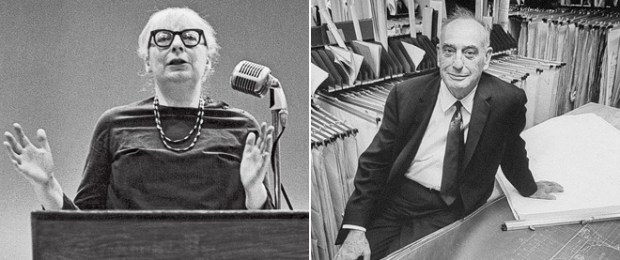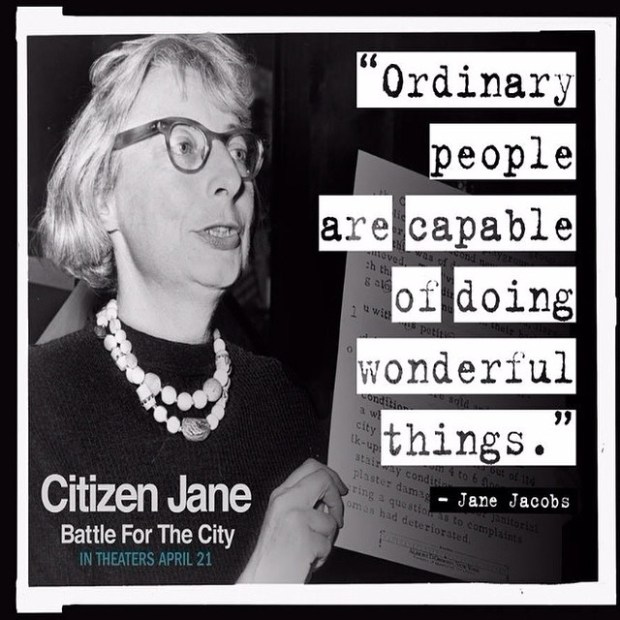Director Matt Trynauer’s new documentary “Citizen Jane” is both a welcome film bio of the late author-activist-urban theorist Jane Jacobs and a fortifying reminder of how committed and creative “people power” can be more than a match against monolithic government and business interests when they have negated any sense of human decency. Jacobs was a writer and magazine editor living in Manhattan’s West Village who developed a homegrown value system about what makes cities work best, an ideal of people-centric short blocks with mixed usage and a vital network of safe and productive interconnectedness among a diverse population. This was spelled out in her first book “The Death and Life of Great American Cities” first published in 1961 and a work that is still influential to this day.
“Death and Life” was both a celebration of spontaneous urban vitality and an unabashed assault on the doctrinal city planning theories of the day, which centered on the construction of endless rows of monolithic housing towers cut through with multi-lane expressways. All this would be accomplished by first enabling the wholesale demolition of the “slum” neighborhoods that Jacobs saw as vital communities. As per the film’s subtitle, a large chunk of “Citizen Jane” concerns the high-profile contest of wills between her and the imperious Robert Moses, New York City’s powerful city-planning czar.

Not the best of friends: Jacobs and Moses.
Moses in his earlier days was known as an enlightened master builder. His first major project was the populist and popular Jones Beach State Park, opened in 1929. By the Fifties and early Sixties, however, he was firmly aligned with the visionary but abstracted Modernist dictates most associated with Swiss-born architect Le Corbusier. Jacobs thought these ideas were poisonous and was pretty blunt about it (the first sentence “The Death and Life” is “This book is an attack on current city planning and rebuilding”). In the trailer below, you can get a taste for Moses’ arrogance. He refers to certain neighborhoods as “cancerous” and insists that his projects will be bulled through at whatever the cost. It was a typical urban renewal attitude at the time and one that Jacobs said made people feel as no more than “subjects of a conquering power.”
That all began to change when Moses wanted to build a road straight through the historic and well-loved Washington Square park in Greenwich Village, for no other discernible reason other than he thought he could and perhaps to extend fashionably expensive Fifth Avenue. Jacobs sprang into action. File footage, period newscasts and TV appearances show a blunt but savvy organizer who could marshal great support (future NYC mayor Ed Koch was one of her early allies) and counteract elitist and sexist belittlement with attention-grabbing tactics (concerned citizens crowding city hall meetings, baby-carriage blockades). When the Washington Sq. road plan was nixed, it was the first setback for Robert Moses, who saw himself as an embodiment of the “Great Man” theory but whom Jacobs breezily derided as being “scared of life.”

There would be other battles to follow and Trynaeur does a pretty fair job of hashing these out for a general audience, with help from interviewees like Anthony Flint (who wrote the book “Wrestling with Moses” on this subject), architect Robert A.M. Stern, architecture critic Paul Goldberger and others. While the presentation here tends to be one-sided, the film does well to trace the gradual ascendancy of Jacobs’ ideas and Moses’ concurrent (and also gradual) fall from grace, with examples like his failure to raze 16 square blocks of her beloved West Village in the name of urban renewal.
For me, the most vivid case history in “Citizen Jane” is the saga of the would-be Lower Manhattan Expressway (LOMEX), a double-pronged Ayn Randian nightmare of a ten-lane highway topped with a Space Age ziggurat on one end. This would have obliterated large chunks of Soho, Little Italy and the Cast Iron district while presumably letting the oligarchs look down on those left behind in the exhaust and neglect, many of them crammed into the long-discredited housing projects that are a prime part of the legacy for Robert Moses and his ilk.

Fountainhead Folly? This proposal for LOMEX dwarfs even the Manhattan Bridge.
New York Gov. Nelson Rockefeller finally shelved the LOMEX project in 1971 and for good measure accepted the last in a long line of Moses’ fit-of-pique resignation letters. Today, Jacobs’ insistence that people need to shape cities for themselves is pretty well embedded. Community input in urban planning is much more prevalent and the public realm in New York and other big cities is often safer and more welcoming for residents and visitors alike. Huge problems remain of course with gentrification and income disparity and the same authoritarian attitudes prevalent in America in the 50s and 60s have been exported: one talking head here describes city planning in China today as “Robert Moses on steroids.” But Jane Jacobs’ idea that our cities are an ecosystem that needs to be understood and cared for to be truly successful can also be exported, and reinforced here at home, and a viewing of “Citizen Jane” would be a good place to start.

Thank goodness for people like Jane Jacobs – It could all have been so different.
That’s so true. A highway similar to what Jane Jacobs stopped in NY almost got built here Boston but was also stopped and instead we got a new transit line and parks. BTW, enjoy your blogging sabbatical this summer!
Phew – common sense and aesthetic taste prevailed.
I am going to have a break from writing new posts but still intend to drop by the blogs I follow – It’s taken over my life a bit of late so got to redress the balance. You seem to do a fine job of doing that so should take a leaf out of your book!
I’ve had writer’s burnout since my book came out so now I just spread my posts a little thinner–about twice a month instead of every week. I am very impressed by the number of posts you’ve done–and the number of page views!
Ah but mine are just web-diary type posts so a lot easier to write and I think the views are mainly because people stumble upon them having googled a particular band or artist. There was a great Proclaimers doc on our BBC the other week which led to a spike in views – Not sure how au fait you are with The Proclaimers but if you can source it, well worth a watch.
I see you don’t monetize your site, don’t waste your traffic, you can earn additional bucks
every month because you’ve got hi quality content. If you want to know how to
make extra money, search for: best adsense alternative Wrastain’s tools